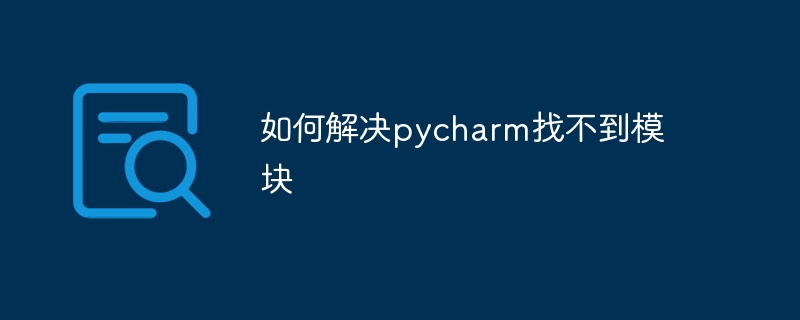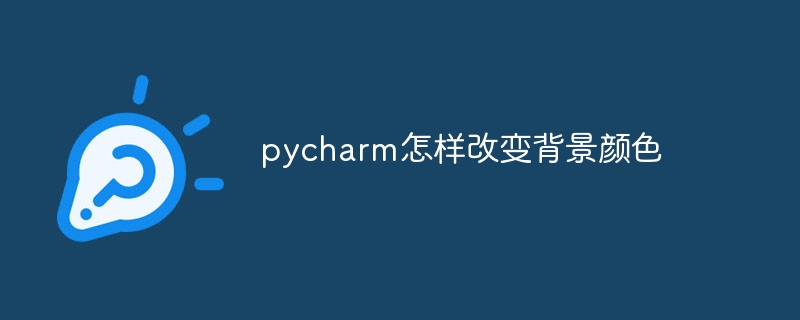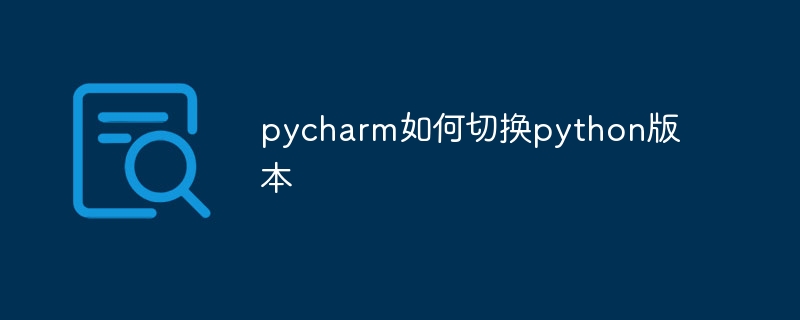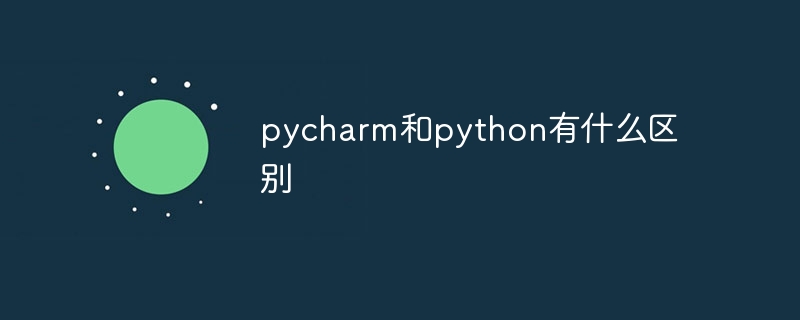 Backend Development
Backend Development Python Tutorial
Python Tutorial PyCharm multi-line comment shortcut key skills: a simple and efficient learning method
PyCharm multi-line comment shortcut key skills: a simple and efficient learning method
Easy-to-learn PyCharm multi-line comment shortcut key skills
PyCharm is a powerful Python integrated development environment that provides many shortcut keys and Tips, one of which is shortcut keys for multi-line comments. In the process of writing code, we often need to add comments to explain the role and function of the code, and PyCharm's multi-line comment shortcut keys can help us quickly add or cancel comments, improving the readability and maintainability of the code. This article will introduce the shortcut key techniques for multi-line comments in PyCharm, and provide specific code examples to help readers better understand and apply them.
In PyCharm, we can use the shortcut key Ctrl / to add or cancel single-line comments. But in the scenario of multi-line comments, the single-line comment shortcut key is obviously not enough. PyCharm provides a more powerful shortcut key Ctrl Shift /, which can add or cancel multiple line comments at the same time. The following are the specific steps:
- Select the multiple lines of code that need to be commented.
- Use the shortcut key Ctrl Shift / to add or cancel multi-line comments.
Below, we will use sample code to demonstrate the shortcut key skills of multi-line comments:
# 示例代码1:使用多行注释快速添加注释
def add(num1, num2):
"""
这是一个用于计算两个数相加的函数
:param num1: 第一个数字
:param num2: 第二个数字
:return: 两个数字的和
"""
return num1 + num2
In the above sample code, we use multi-line comments to annotate functions illustrate. By selecting the code block that needs to be commented and using the Ctrl Shift / shortcut key, PyCharm will automatically add the comment symbol ''' above the selected code, and at the same time add the comment symbol ''' at the end of the code block, so that the selected code is implemented Multi-line comments.
In addition to adding comments through multi-line comment shortcut keys, we can also use the same shortcut keys to cancel multi-line comments. Just select the commented code block again, use Ctrl Shift / shortcut key, PyCharm will automatically delete the comment symbol ''' in the code, thereby canceling multi-line comments.
# 示例代码2:使用多行注释快速取消注释 #def subtract(num1, num2): # """ # 这是一个用于计算两个数相减的函数 # :param num1: 第一个数字 # :param num2: 第二个数字 # :return: 两个数字的差 # """ # return num1 - num2
In the above example code 2, we used multi-line comments to annotate the function. Select the commented code block again, use Ctrl Shift / shortcut key, PyCharm will automatically delete the comment symbol ''' in the code, thereby uncommenting.
By adding and canceling multi-line comments through shortcut keys, we can more conveniently comment on the code and cancel the comments, which improves the readability and maintainability of the code.
Summary:
This article introduces the shortcut key skills for adding and canceling multi-line comments in PyCharm, and demonstrates its use through specific code examples. Use the shortcut key Ctrl Shift / to effectively add or cancel multi-line comments. When writing code, we can use this technique to improve the readability and maintainability of the code. I hope these tips will provide some help to readers when using PyCharm for Python development.
The above is the detailed content of PyCharm multi-line comment shortcut key skills: a simple and efficient learning method. For more information, please follow other related articles on the PHP Chinese website!
 如何解决pycharm找不到模块Dec 04, 2023 pm 01:31 PM
如何解决pycharm找不到模块Dec 04, 2023 pm 01:31 PM解决pycharm找不到模块的方法:1、检查python解释器;2、安装缺失的模块;3、检查项目结构;4、检查系统路径;5、使用虚拟环境;6、重启PyCharm或电脑。PyCharm找不到模块是一个常见的问题,但通常可以通过一些步骤来解决,这个问题可能由多种原因引起,比如Python解释器配置不正确、模块没有正确安装或者PyCharm的项目设置有问题。
 pycharm打不开怎么办Dec 07, 2023 pm 05:09 PM
pycharm打不开怎么办Dec 07, 2023 pm 05:09 PMpycharm打不开可以通过检查系统要求、重新启动计算机、检查防病毒软件和防火墙设置、检查日志文件、更新PyCharm、检查系统环境变量、重置PyCharm设置、检查日志文件和报错信息、卸载并重新安装PyCharm和向PyCharm官方支持寻求帮助来解决。详细介绍:1、检查系统要求,确保计算机满足PyCharm的最低系统要求;2、重新启动计算机等等。
 pycharm怎么批量替换Dec 07, 2023 pm 05:27 PM
pycharm怎么批量替换Dec 07, 2023 pm 05:27 PMpycharm可以通过使用搜索和替换功能、结合正则表达式进行高级替换、使用代码重构功能、使用Structural Search and Replace和导入外部工具进行批量替换来批量替换。详细介绍:1、使用搜索和替换功能,打开PyCharm,打开要进行批量替换的项目或文件夹等等。
 pycharm注释快捷键有哪些Dec 05, 2023 pm 02:14 PM
pycharm注释快捷键有哪些Dec 05, 2023 pm 02:14 PMpycharm注释快捷键有:1、单行注释,使用“#”;2、多行注释,使用三引号“””;3、批量注释,选择要注释的文本行,背景变化后,同时按“Ctrl+/”;4、取消批量注释,选择已注释的文本行,背景变化后,同时按“Ctrl+/”;5、批量缩进,选择要缩进的文本行,背景变化后,按下“TAB”键;6、取消批量缩进,选择要缩进的文本行,背景变化后,按下“SHIFT+TAB”键。
 pycharm怎样改变背景颜色Dec 07, 2023 pm 04:58 PM
pycharm怎样改变背景颜色Dec 07, 2023 pm 04:58 PMpycharm改变背景颜色的方法:1、使用主题设置,在PyCharm设置对话框中,选择 "Editor",选择喜欢的主题,点击 "Apply"即可;2、使用自定义背景颜色,在 "Editor"选项卡中,点击"Background",选择喜欢的颜色,确认即可;3、使用快捷键快速更改背景颜色,按下 "Ctrl+Alt+S" 组合键打开设置对话框,跟上面一样选择型号的颜色即可等等。
 pycharm如何切换python版本Dec 08, 2023 pm 02:14 PM
pycharm如何切换python版本Dec 08, 2023 pm 02:14 PMpycharm切换python版本的方法:1、通过项目配置,在“New Project”或“Open”对话框中,可以指定Python解释器的版本;2、使用虚拟环境,虚拟环境为每个项目提供了一个隔离的Python环境,可以在不影响其他项目的情况下更改和升级库和依赖项;3、使用系统环境变量,可以添加一个新的系统环境变量,指向使用的Python解释器的路径;4、使用第三方插件等等。
 pycharm和python有什么区别Dec 04, 2023 pm 04:26 PM
pycharm和python有什么区别Dec 04, 2023 pm 04:26 PMpycharm和python区别是:1、PyCharm是一款软件开发工具,而Python则是一种编程语言;2、PyCharm提供了丰富的功能和工具,而Python本身提供了各种库和模块;3、PyCharm主要用于编写、调试和运行Python代码,而Python语言可以应用于各种开发场景等等。
 pycharm快捷键大全Dec 04, 2023 pm 04:39 PM
pycharm快捷键大全Dec 04, 2023 pm 04:39 PMpycharm快捷键有:1、Ctrl + C,复制选定的文本;2、Ctrl + X,剪切选定的文本;3、Ctrl + V,粘贴剪切板上的文本;4、Ctrl + Z:撤销上一次操作;5、Ctrl + Y:重做上一次取消的操作;6、Ctrl + D:复制当前行或选中的部分,并将其插入到下一行;7、Tab:缩进选中的代码;8、Shift + Tab:取消缩进选中的代码等等。


Hot AI Tools

Undresser.AI Undress
AI-powered app for creating realistic nude photos

AI Clothes Remover
Online AI tool for removing clothes from photos.

Undress AI Tool
Undress images for free

Clothoff.io
AI clothes remover

AI Hentai Generator
Generate AI Hentai for free.

Hot Article

Hot Tools

Notepad++7.3.1
Easy-to-use and free code editor

PhpStorm Mac version
The latest (2018.2.1) professional PHP integrated development tool

SublimeText3 Mac version
God-level code editing software (SublimeText3)

EditPlus Chinese cracked version
Small size, syntax highlighting, does not support code prompt function

mPDF
mPDF is a PHP library that can generate PDF files from UTF-8 encoded HTML. The original author, Ian Back, wrote mPDF to output PDF files "on the fly" from his website and handle different languages. It is slower than original scripts like HTML2FPDF and produces larger files when using Unicode fonts, but supports CSS styles etc. and has a lot of enhancements. Supports almost all languages, including RTL (Arabic and Hebrew) and CJK (Chinese, Japanese and Korean). Supports nested block-level elements (such as P, DIV),




